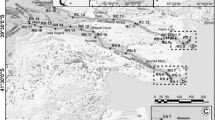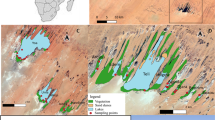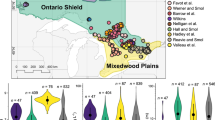Abstract
Diatom surface sediment samples and corresponding water chemistry were collected from 56 lakes across a natural conductivity gradient in western Uganda (reflecting a regional climatic gradient of effective moisture) to explore factors controlling diatom distribution. Here we develop a regional training set from these crater lakes to test the hypothesis that this approach, by providing more appropriate and closer analogues, can improve the accuracy of palaeo-conductivity reconstructions, and so environmental inferences in these lake systems compared to larger training sets. We compare this output to models based on larger, but geographically and limnologically diverse training sets, using the European Diatom Database Initiative (EDDI) database. The relationships between water chemistry and diatom distributions were explored using canonical correspondence analysis (CCA) and partial CCA. Variance partitioning indicated that conductivity accounted for a significant and independent portion of this variation. A transfer function was developed for conductivity (r 2jack = 0.74). Prediction errors, estimated using jack-knifing, are low for the conductivity model (0.256 log10 units). The resulting model was applied to a sedimentary sequence from Lake Kasenda, western Uganda. Comparison of conductivity reconstructions using the Ugandan crater lake training set and the East Africa training set (EDDI) highlighted a number of differences in the optima of key diatom taxa, which lead to differences in reconstructed values and could lead to misinterpretation of the fossil record. This study highlights issues of how far transfer functions based on continental-scale lake datasets such as the EDDI pan-African models should be used and the benefits that may be obtained from regional training sets.






Similar content being viewed by others
References
Atlas of Uganda (1962) Ugandan Department of Lands and Surveys. The Government Printer, Entebbe
Avery L, Shinneman C, Edlund MB, Almendinger JE, Sonunkhishig N (2009) Diatoms as indicators of water quality in Western Mongolian lakes: a 54-site calibration set. J Paleolimnol 42:373–389
Barker P (1990) Diatoms as palaeolimnological indicators: a reconstruction of Late Quaternary environments in two East African salt lakes. Unpublished PhD Thesis, Loughborough University of Technology
Barker P, Telford R, Gasse F, Florian T (2002) Late Pleistocene and Holocene palaeohydrology of Lake Rukwa, Tanzania, inferred from diatom analysis. Palaeogeogr Palaeoclimatol Palaeoecol 187:295–305
Battarbee RW (2000) Palaeolimnolgical approaches to climate change, with special regard to the biological record. Quat Sci Rev 19:107–204
Battarbee R, Jones VJ, Flower RJ, Cameron NG, Bennion H, Carvalo L, Juggins S (2001) Diatoms. In: Smol JP, Birks HJB, Last WM (eds) Tracking environmental change using lake sediments. Vol. 3: terrestrial, algal, and siliceous indicators. Kluwer, Dordrecht, pp 155–202
Birks HJB (1995) Quantitative palaeoenvironmental reconstructions. In: Maddy D, Brew JS (eds) Statistical modelling of quaternary science data. Quaternary Research Association Technical Guide 5, Cambridge, pp 161–254
Borcard D, Legendre P, Drapeau P (1992) Partialling out the spatial component of ecological variation. Ecology 73:1045–1055
Caljon AG, Cocquyt CZ (1992) Diatoms from surface sediments of the northern part of Lake Tanganyika. Hydrobiologia 230:135–156
Chalié F, Gasse F (2002) Late Glacial-Holocene diatom record of water chemistry and lake level change from the tropical East African Rift Lake Abiyata (Ethiopia). Palaeogeogr Palaeoclimatol Palaeoecol 187:259–283
Cocquyt C (1998) Diatoms from the Northern Basin of Lake Tanganyika. Bibliotheca Diatomologica 39. Crammer, Berlin
Cook RD, Weisberg S (1982) Residuals and influence in regression. Chapman and Hall, New York
Davies SJ, Metcalfe SE, Caballero ME, Juggins S (2002) Developing diatom-based transfer functions for Central Mexican lakes. Hydrobiologia 467:199–213
Dong X, Bennion H, Battarbee R, Yang X, Yang H, Liu E (2008) Tracking eutrophication in Taihu Lake using the diatom record: potential and problems. J Paleolimnol 40:413–429
Eggermont H, Verschuren D (2004) Subfossil Chironomidae from East African low- and mid-elevation lakes. 1. Tanypodinae and Orthocladiinae. J Paleolimnol 32:383–412
Eggermont H, Heiri O, Verschuren D (2006) Subfossil Chironomidae (Insecta: Diptera) as quantitative indicators for past salinity variation in African lakes. Quat Sci Rev 25:1966–1994
Fritz SC, Cumming BF, Gasse F, Laird K (1999) Diatoms as indicators of hydrologic and climate change in saline lakes. In: Stoermer EF, Smol JP (eds) The diatoms: applications for environmental and earth sciences. Cambridge University Press, Cambridge, pp 41–72
Gasse F (1986) East African diatoms: taxonomy, ecological distribution. Bibliotheca Diatomologica, vol 11. Crammer, Berlin
Gasse F, Tekaia F (1983) Transfer functions for estimating paleoecological conditions (pH) from East African diatoms. Hydrobiologia 103:85–90
Gasse F, Van Campo E (1994) Abrupt post-glacial climate events in West Asia and North Africa monsoon domains. Earth Planet Sci Lett 126:435–456
Gasse F, Talling JF, Kilham P (1983) Diatom assemblages in East Africa: classification, distribution and ecology. Rev Hydrobiol Trop 116:3–34
Gasse F, Juggins S, Khelifa LB (1995) Diatom-based transfer functions for inferring past hydrochemical characteristics of African lakes. Palaeogeogr Palaeoclimatol Palaeoecol 117:31–54
Grasshoff K, Ehrhardt M, Kremling K (1983) Methods of seawater analysis. Verlag Chemie, Weinheim
Hammer UT (1986) Saline lake ecosystems of the world. In: Dumont HJ (ed) Monographiae Biologicae. Junk, Dordrecht
Hill MO, Gauch HG (1980) Detrended correspondence analysis: an improved ordination technique. Plant Ecol 42:47–58
Hübener T, Dreßler M, Schwarz A, Langner K, Adler S (2008) Dynamic adjustment of training sets (‘moving-window’ reconstruction) by using transfer functions in palaeolimnology—a new approach. J Paleolimnol 40:79–95
Huisman J, Olff H, Fresco LFM (1993) A hierarchical set of models for species response analysis. J Veg Sci 4:37–46
Hutchison GE (1957) A treatise on limnology. Wiley, New York
Juggins S (2003) C2, user guide: software for ecological and palaeoecological data analysis and visualisation. University of Newcastle, Newcastle upon Tyne
Kingston JC, Birks HJB, Uutala AJ, Cumming BF, Smol JP (1992) Assessing the trends in fishery resources and lake water aluminium from palaeolimnological analyses of siliceous algae. Can J Fish Aquat Sci 49:127–138
Kizito YS, Nauwerck A, Chapman LJ, Koste W (1993) A limnological survey of western Uganda crater lakes. Limnologica 23:335–347
Krammer K, Lange-Bertalot H (1986) Bacillariophyceae. 1. Teil. Naviculaceae. Süßwasserflora von Mitteleuropa, Band 2/1. Gustav Fischer Verlag, Stuttgart
Krammer K, Lange-Bertalot H (1988) Bacillariophyceae. 2. Teil. Bacillariaceae, Epithemiaceae, Surirellaceae. Süßwasserflora von Mitteleuropa, Band 2/2. Gustav Fischer Verlag, Stuttgart
Krammer K, Lange-Bertalot H (1991a) Bacillariophyceae. 3. Teil. Centrales, Fragilariaceae, Eunotiaceae. Süßwasserflora von Mitteleuropa, Band 2/3. Gustav Fischer Verlag, Stuttgart
Krammer K, Lange-Bertalot H (1991b) Bacillariophyceae. 4. Teil. Achnanthaceae, kritsche erganzungen zu Navicula (Lineolatae) und Gomphonema Gesamliteraturverzeichnis. Süßwasserflora von Mitteleuropa, Band 2/4. Gustav Fischer Verlag, Stuttgart
Langdale-Brown I, Osmaston HA, Wilson JG (1964) The vegetation of Uganda and its bearing on land-use. The Government Printer, Entebbe
Melack JM (1978) Morphometric, physical and chemical features of the volcanic crater lakes of western Uganda. Arch Hydrobiol 84:430–453
Mills K (2009) Ugandan crater lakes: limnology, palaeolimnology and palaeoenvironmental history. Unpublished Ph.D. Thesis, Loughborough University
Mitrovic SM, Chessman BC, Davie A, Avery EL, Ryan N (2008) Development of blooms of Cyclotella meneghiniana and Nitzschia spp. (Bacillariophyceae) in a shallow river and estimation of effective suppression flows. Hydrobiologia 596:173–185
Racca JMJ, Prairie YT (2004) Apparent and real bias in numerical transfer functions in palaeolimnology. J Paleolimnol 31:117–124
Reed JM (1998) A diatom-conductivity transfer function for Spanish salt lakes. J Paleolimnol 19:399–416
Renberg I (1990) A procedure for preparing large sets of diatom slides from sediment cores. J Paleolimnol 4:87–90
Renberg I (1991) The HON-Kajak sediment corer. J Paleolimnol 6:167–170
Roubiex V, Lancelot C (2008) Effect of salinity on growth, cell size and silification of an euryhaline freshwater diatom: Cyclotella meneghiniana Kütz. Transit Waters Bull 1:31–38
Russell JM, Eggermont H, Verschuren D (2007) Spatial complexity during the Little Ice Age in tropical East Africa: sedimentary records from contrasting crater lake basins in western Uganda. Holocene 17:183–193
Russell JM, McCoy SJ, Verschuren D, Bessems I, Huang Y (2009) Human impacts, climate change, and aquatic ecosystem response during the past 2,000 years at Lake Wandakara, Uganda. Quat Res 72:315–324
Ryves DB, Battarbee RW, Fritz SC (2009) The dilemma of disappearing diatoms: incorporating diatom dissolution data into palaeoenvironmental modelling and reconstruction. Quat Sci Rev 28:120–136
Ryves DB, McGowan S, Anderson NJ (2002) Development and evaluation of a diatom-conductivity model from lakes in West Greenland. Freshw Biol 47:995–1014
Ryves DB, Mills K, Bennike O, Brodersen KP, Lamb AL, Leng MJ, Russell JM, Ssemmanda I (2011) Environmental change over the last millennium recorded in two contrasting crater lakes in western Uganda, eastern Africa (Lakes Kasenda and Wandakara). Quat Sci Rev 30:555–569
Ssemmanda I, Ryves DB, Bennike O, Appleby PG (2005) Vegetation history in west Uganda during the last 1200 years: a sediment-based reconstruction from two crater lakes. Holocene 15:119–132
Stager JC, Ryves D, Cumming BF, Meeker LD, Beer J (2005) Solar variability and the levels of Lake Victoria, East Africa, during the last millennium. J Paleolimnol 33:243–251
Stager JC, Cocquyt C, Bonnefille R, Weyhenmeyer C, Bowerman N (2009) A late Holocene paleoclimatic history of Lake Tanganyika, East Africa. Quat Res 72:47–56
Stager JC, Ryves DB, Chase BM, Pausata SR (2011) Catastrophic drought in the Afro-Asian monsoon region during Heinrich Event 1. Science 331:1299–1302
ter Braak CJF (1995) Non-linear methods for multivariate statistical calibration and their use in palaeoecology: a comparison of inverse (k-nearest neighbours, partial least squares and weighted averaging partial least squares) and classical approaches. Chemom Intell Lab Syst 28:165–180
ter Braak CJF, Juggins S (1993) Weighted averaging partial least squares regression (WA-PLS): an improved method for reconstructing environmental variables from species assemblages. Hydrobiologia 269(270):485–502
Tuchman ML, Theriot E, Stoermer EF (1984) Effects of low level salinity concentrations on the growth of Cyclotella meneghinianana Kütz (Bacillariophyta). Arch Protistenkd 128:319–326
Verschuren D (2003) Lake-based climate reconstruction in Africa: progress and challenges. Hydrobiologia 500:315–330
Wilson SE, Cumming BF, Smol JP (1996) Assessing the reliability of salinity inference models from diatom assemblages: an examination of a 219-lake data set from western North America. Can J Fish Aquat Sci 53:1580–1594
Wright SW, Wright JW, Jeffrey SW (1997) High resolution system for chlorophylls and carotenoids of marine phytoplankton. In: Jeffrey SW, Mantoura RFC, Wright SW (eds) Phytoplankton pigments in oceanography: a guide to advanced methods. SCOR-UNESCO, Paris, pp 327–360
Acknowledgments
This work was completed by KM as part of a Ph.D. carried out at and funded by Loughborough University. KM is currently a Research Fellow working within the University of Ballarat’s Collaborative Research Network. Financial support for the fieldwork was provided through NERC (UK) within a New Investigators’ Competition award (NE/D000157/1) to DBR, and grants from the Quaternary Research Association and the British Institute in Eastern Africa to KM. Additional support for isotopic analyses of water samples by the NERC Isotope Geosciences Laboratory (NIGL award code IP/884/1105). Fieldwork in Uganda was supported by the Department of Geology at Makerere University, Makerere University Biological Field Station (Kibale) and Loughborough University. We thank the Uganda National Council for Science and Technology (permit EC482), Uganda Wildlife Authority and the Office of the President for fieldwork permission. We thank Dirk Verschuren, Bob Rumes, Hilde Eggermont (Ghent University) for providing sediment samples and lake data and Georg Schettler (GeoForschungsZentrum), Lei Chou (Université Libre de Bruxelles) and Renaat Dasseville (Ghent University) for the processing of the water chemistry samples. Many sincere thanks go to John Anderson, Sergi Pla, Immaculate Ssemmanda, Julius Lejju and (especially) Richard Nyakoojo for their invaluable help in the field.
Author information
Authors and Affiliations
Corresponding author
Electronic supplementary material
Below is the link to the electronic supplementary material.
Rights and permissions
About this article
Cite this article
Mills, K., Ryves, D.B. Diatom-based models for inferring past water chemistry in western Ugandan crater lakes. J Paleolimnol 48, 383–399 (2012). https://doi.org/10.1007/s10933-012-9609-2
Received:
Accepted:
Published:
Issue Date:
DOI: https://doi.org/10.1007/s10933-012-9609-2




